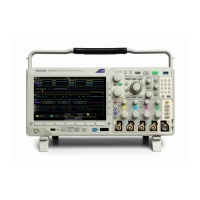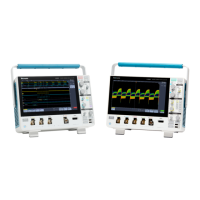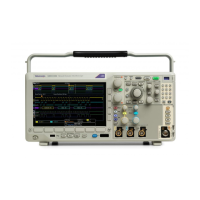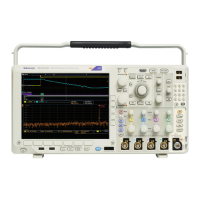
Do you have a question about the Tektronix MDO3104 and is the answer not in the manual?
| Brand | Tektronix |
|---|---|
| Model | MDO3104 |
| Category | Test Equipment |
| Language | English |
Essential precautions for safe operation and product care, including general warnings and cautions.
Specific safety guidelines for qualified personnel performing service or maintenance on the product.
Definitions of terms and explanation of symbols used throughout the manual for clarity and hazard identification.
Details EMC directives, safety standards, and certifications like EU low voltage, US/Canadian testing lab listings.
Explains product ratings, overvoltage categories, and environmental handling for proper operation and disposal.
Highlights major capabilities and explains manual conventions, icons, and symbols for user guidance.
Guides on unpacking, verifying standard accessories, and unpacking optional items before setup.
Provides operational specifications, cleaning, and probe connection guidance.
Covers powering the oscilloscope on/off, functional checks, and probe compensation procedures.
Details application module installation, bandwidth upgrades, language/time settings, and firmware upgrades.
Describes methods for connecting the oscilloscope to a computer via VISA, e*Scope, socket server, or USB keyboard.
Provides an overview of the front panel layout, including menus, controls, connectors, and display elements.
Explains navigation of menus, use of multipurpose knobs, and functions of various buttons.
Details controls for spectral analysis, cursors, zoom, pan, and waveform display adjustments.
Explains acquisition modes, waveform records, sampling, and fundamental trigger concepts.
Guides on setting up and triggering on various serial and parallel data buses with application modules.
Covers trigger events, pre/posttrigger data, trigger modes (Normal, Auto), and holdoff adjustments.
Explains various trigger types (Edge, Sequence, Pulse Width, Logic, Bus) and their setup parameters.
Procedures for setting up triggers on specific serial and parallel buses like CAN, LIN, SPI, and RS-232.
Covers using markers, cursors, automatic measurements, histograms, math, and FFT for detailed signal analysis.
How to monitor signals against masks and perform automated tests with pass/fail results.
Using built-in tools to trigger on and display video signals, including test patterns and actual video.
Utilizing the Power Analysis Module for automated acquisition and analysis of power signals.
Explains file structure on external media, naming conventions, and managing drives/directories.
Procedures for saving screen images, waveforms, traces, and instrument setups to internal or external storage.
Guides on printing oscilloscope screen images to connected printers and configuring email printing.
Details security functions like password protection, memory erasure, and port/firmware control.
Configuring the Save button for one-push saving of defined file types and parameters.
How to access the AFG, change waveform types, and create custom arbitrary waveforms.
Useful tips for saving, loading, and scaling arbitrary waveforms, including load impedance and noise settings.
Visual representations of instrument performance characteristics, such as bandwidth versus frequency.
General safety precautions for using probes and accessories, including warnings about electric shock.
Basic information on TPP0250/0500B/1000 probes, how to connect them, and standard accessories.
Guidance on probe compensation, technical specifications, and optional accessories for TPP probes.
Essential safety precautions specific to using the probes and their accessories, including warnings.
Overview of the P6316 logic probe, its connection to the oscilloscope, and to the circuit.
Procedure to verify probe functionality and a common use case for digital signal analysis.
Lists accessories for the P6316 probe and its electrical, mechanical, and environmental specifications.
Essential safety precautions for using the P6316 logic probe to avoid potential hazards.
Details on the dual licensing of the OpenSSL toolkit and the terms governing its use and distribution.
The terms and conditions of the OpenSSL License governing the use and distribution of the software.
The licensing terms for the original SSLeay components included in the toolkit.
An index listing of symbols and numerical references used within the manual for quick lookup.











